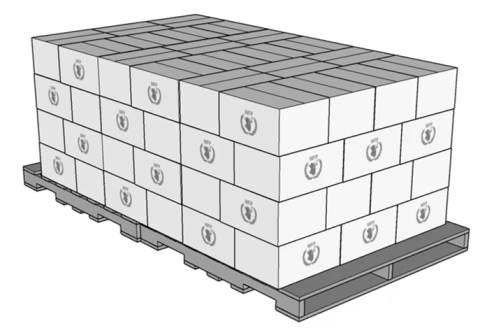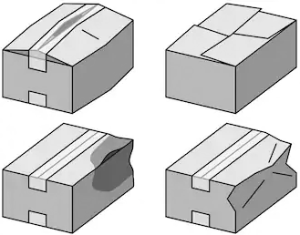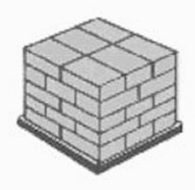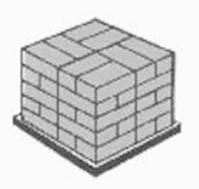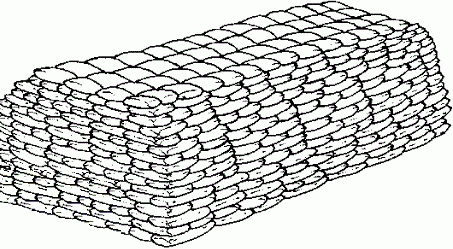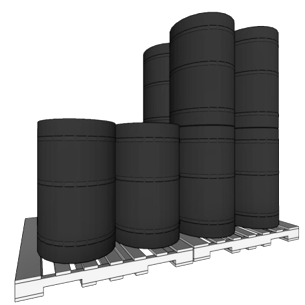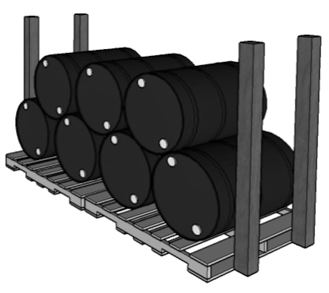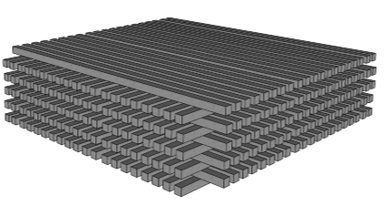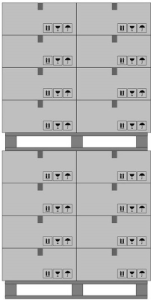Ground storage and stacking is extremely common in humanitarian warehousing operations, especially in field settings near the final distribution points. Storing cargo on the ground and/or in stacks has become a default, largely because the necessary infrastructure to manage special warehouse equipment of storage solutions isn’t always available, there are limited skill sets available in the local market, and many of the smaller field warehouses are by nature transitional.
In NFI operations, stacking can be challenging. An average humanitarian program can have dozens of individual SKUs to fulfil a variety of programmatic needs. With an increased number of SKUs, maintaining large piles of cargo can make identifying and managing individual cargo items difficult. There are several mitigation measures agencies can take when faced with generating cargo stacks in a warehouse.
Cargo stored on the ground or in stacks should always be clearly demarcated. A stock card should physically accompany every stored SKU item, and warehouse managers should be able to quickly identify and pick orders without having to sort through piles of non-related items.
Cartons/Bales/Sacks
Wherever possible, stacked cargo should be stored in as uniform manner as possible for quick counting and identification. To facilitate this, warehouse managers must:
- Identify the pallet configuration; single pallet vs. multiple pallets pushed together on the ground.
- Plan a “layer” system for the stack. Each layer and row of carton/bale/sack should have the same number of handling units.
- Start with a base layer on the lowest level first. Once the lowest later is complete, repeat the second layer in an interlocking pattern for stability.
- Plan stack layers for like item units only. Avoid stacking/layering different items/SKUs.
- Ideally, plan to keep only units from the same consignment in the same stack.
- Cargo should only ever be removed from the top layer to avoid instability.
- Cartons/bales/sacks should not be leaning off the edge of the pallet.
Stacked cargo should be stored as safely as possible. Stacks should be layered in interlocking patterns; a non-interlocking stack is far more likely to fall over and/or put pressure on the lowest layer of cartons. Partially empty cartons should not be stored at the bottom of the stack to avoid the lowest levels from caving in and causing the stack to collapse.
There are multiple varieties of alternatives for stacking loose cartons and irregular shapes. The configuration will depend on the commodity itself, the space requirements of the warehouse, and the speed and skill of the warehouse staff. Some possible configurations might include:
Many ground stacking operations also utilize what is called "pyramid stacking." Pyramid stacks are useful for durable, bulky items and in contexts when high volumes of uniform items need to be stored in a relatively small space. Pyramid stacks - sometimes also called "stair stacking" have interlocking layers with reduced diameters the further up the stack goes. The pyramid shape prevents dangerous items from falling, and may make accessing the top layer easier for hand loaders.
No matter what the stacking configuration looks like, stacks should not be stored above an unsafe height.
- A safe height may be context specific; for NFI cartons/bales/sacks of any size that are heavy enough injure workers, stacks should never exceed 2.5 meters, while light voluminous items such as empty plastic jerry cans might be stored higher if required.
- Food bags, blanket bales or sacks of concrete can be stored in pyramid stacks, however pyramid stacks should still only be made as high as is contextually safe.
- No matter the height, warehouse workers should be able to safely withdraw cargo from the top layer without risk of falling or causing the stack to collapse.
- A stack should not surpass a ratio of 3:1 - the height cannot be 3 times the horizontal width of the base.
- Stacks should never be so high that they come into contact with the ceiling, and at least half a meter space should be left between the top of the stack and the ceiling for accessing items as needed.
Stacks should never exceed 6 meters in length, or a maximum floor space of 6 x 6 meters. Excessively wide or large stacks can cause multiple problems:
- Spoiled or damaged items in the middle are difficult to spot or deal with.
- Practising FIFO/FEFO may be difficult if cargo in the middle of a large stack is inaccessible.
- Visual counting may be difficult or impossible.
- Excessive weight in a single area of the warehouse may lead to structural risks.
Stacked items should not be slumping or falling over. Crushed or damaged units at the bottom of stacks should be addressed immediately; crushed items should be moved to the top of the stack, and if possible/necessary, reduce the height of the stack to prevent further damage.
Cylindrical Items
Ground storage of cylindrical items must be done in way to prevent items from rolling or falling. Ideally, items like tires and metal drums should be stored with their flat surfaces facing downward on a pallet or tarp. In some cases, cylindrical items may not be able to be safely stacked on their flat surfaces due to height restrictions, weight concerns, or the overall dimensions of the item – in which case guard barriers can be built outside the pallet or floor storage to keep the items in one place. Any guard barrier should be strong enough to contain the weight of the combined items.
Timber/Lumber
Loose timber and lumber are commonly stored throughout the humanitarian sector. Timber should:
- Ideally be stored outside in a covered space.
- Separated by type/length/requirement.
- Be easy to count.
Thought it may be tempting to stack timber in a pile, dense piles of wood can lead to infestation or rot, and make proper accounting very difficult. To facilitate timber management, solutions might include:
- Bundles - Bind lumber/timber items into uniform bundles with identical piece counts. This will speed up counting, and make bulk moving of lumber/timber faster. Bundles are opened one at a time to facilitate pick orders. Bundles should still remain a reasonable size, and not be so large they break their bindings.
- Layer Stacks - Stack lumber in uniform, interlocking patterns, much like laying layers for a stack of cartons/bales/sacks. Laying an interlocking pattern requires defining a base layer, and then repeating the same number of units on the next layer, and so on. The interlocking pattern allows for ventilation, something bundling cannot. An interlocking pattern of lumber/timber will always result in a fairly large foot print however, so stacking is only recommended when outside storage isn’t an issue.
Double Stacking Pallets
Double stacked pallets are defined by one or more pallets placed on top of each other without the additional layer of a pallet rack or support structure. Double stacking is fairly common in transport, but should be avoided for any form of medium to long term storage in warehouses. A double stacked pallet can easily fall over and injure warehouse workers if any part of the bottom pallet is compromised, often without warning. A collapsed double stacked pallet can also easily destroy the contents of one or both of the individual pallets. With the inconsistent flows and constant changes of a humanitarian supply model, a double stacked pallet may end up being stored for much longer than originally planned, and managers may forget or simply not realise the dangers of double stacking.


